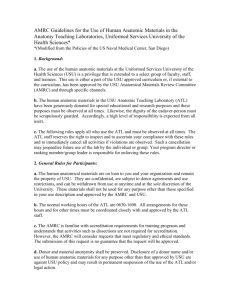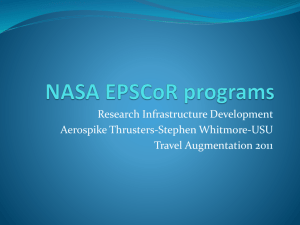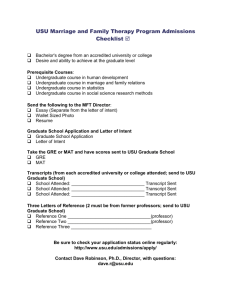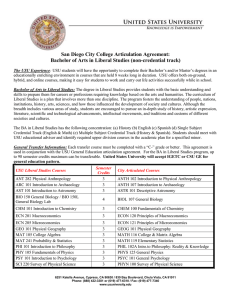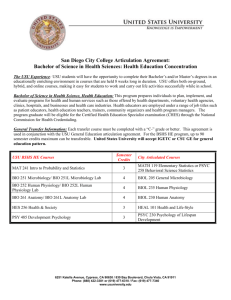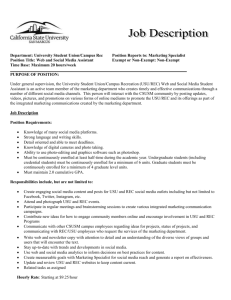USU Form 3213 - Uniformed Services University of the Health
advertisement
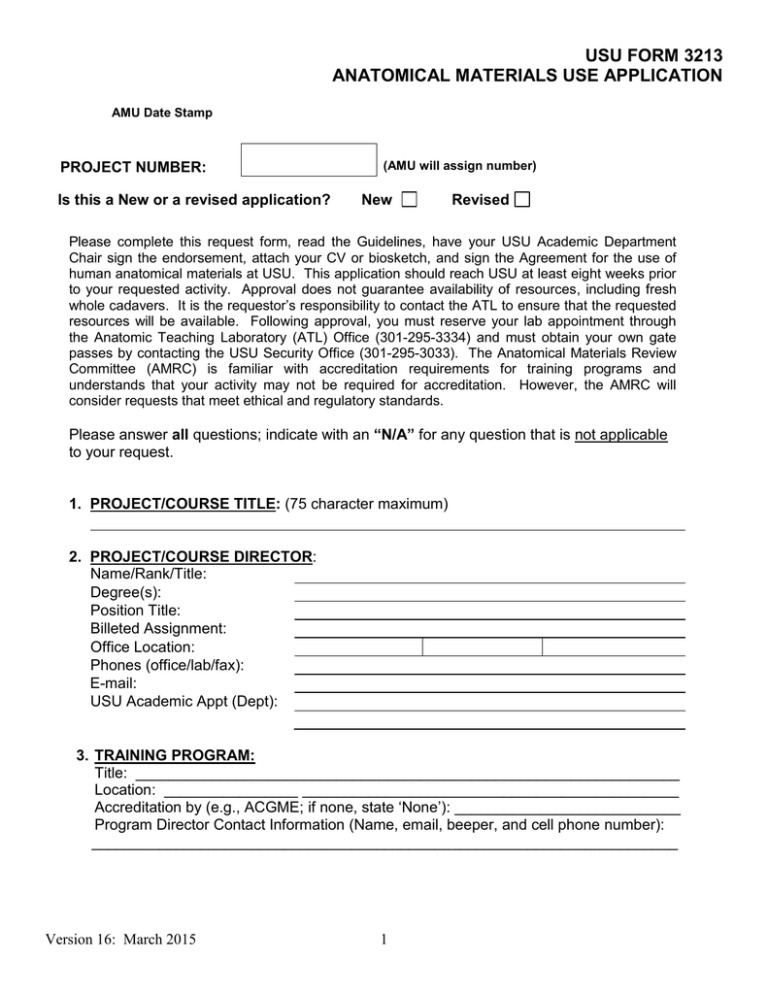
USU FORM 3213 ANATOMICAL MATERIALS USE APPLICATION AMU Date Stamp PROJECT NUMBER: Is this a New or a revised application? (AMU will assign number) New Revised Please complete this request form, read the Guidelines, have your USU Academic Department Chair sign the endorsement, attach your CV or biosketch, and sign the Agreement for the use of human anatomical materials at USU. This application should reach USU at least eight weeks prior to your requested activity. Approval does not guarantee availability of resources, including fresh whole cadavers. It is the requestor’s responsibility to contact the ATL to ensure that the requested resources will be available. Following approval, you must reserve your lab appointment through the Anatomic Teaching Laboratory (ATL) Office (301-295-3334) and must obtain your own gate passes by contacting the USU Security Office (301-295-3033). The Anatomical Materials Review Committee (AMRC) is familiar with accreditation requirements for training programs and understands that your activity may not be required for accreditation. However, the AMRC will consider requests that meet ethical and regulatory standards. Please answer all questions; indicate with an “N/A” for any question that is not applicable to your request. 1. PROJECT/COURSE TITLE: (75 character maximum) 2. PROJECT/COURSE DIRECTOR: Name/Rank/Title: Degree(s): Position Title: Billeted Assignment: Office Location: Phones (office/lab/fax): E-mail: USU Academic Appt (Dept): 3. TRAINING PROGRAM: Title: _________________________________________________________________ Location: ________________ _____________________________________________ Accreditation by (e.g., ACGME; if none, state ‘None’): ___________________________ Program Director Contact Information (Name, email, beeper, and cell phone number): ______________________________________________________________________ Version 16: March 2015 1 4. TYPE OF ACTIVITY REQUESTED (check one): Educational/Training: Research:* *Note: For research requests the applicant must provide a complete anatomic research protocol (USU Form 3214) and Assurance Supplement (USU Form 3208), in addition to this form, to the USU Office of Research (Room A1032) for further processing and forwarding to the AMRC. Non- USU billeted applicants may submit the equivalent local protocol approved by their local research approval authority in lieu of USU Form 3214. A non-USU billeted applicant who wishes to serve as a Principal Investigator (PI) on an anatomic research protocol must establish USU PI eligibility through his/her USU academic department Chair; otherwise a USU billeted individual must serve as PI. Note that the AMRC may request other information as well and may request that the applicant appear in person before the Committee. 5. ANATOMICAL MATERIALS REQUESTED: a. Whole Cadavers: Gender Quantity: Male ________ Total Number requested: Fresh:* ________ Female ________ Either ______ Preserved: ________ b. Other Specimens/Materials (e.g., upper torsos, lower torsos, heads, etc.): Description: _______________________________________________________ Gender Quantity: Male ________ Total Number requested: Fresh:* ________ Female _______ Either ______ Preserved: _______ (*Note: Fresh whole cadavers are available on a limited basis and only on non-holidays and from Tuesday through Thursday; please coordinate with the ATL staff to allow ample time to prepare the specimens. In addition, gender of cadavers may be requested but cannot be guaranteed.) ** ANATOMICAL MATERIALS MAY NOT BE REMOVED FROM THE ATL** 6. ANATOMICALTEACHING LAB DATES AND TIMES: Date(s) & Time(s) requested: _______________________________________________ Preferred timing: During the week? _____________ On Which Day(s)? _____________ During What Hours? ________________ After Normal Duty Hrs (0800-1600)? __________ Weekend? __________________ Weekend Days/Hours __________________________ ***Please coordinate with ATL Director if your request includes after duty hours or weekends. Version 16: March 2015 2 7. ROOMS REQUESTED: Single Dissecting Room: ___________ ATL*: Entire Lab (G039)? _________________ Section of Lab? __________________ ATL Conference Room* (G028): _______________________________ * Note: These rooms also require submission of USU Room Requests. Call the MDL at 295-3301 for assistance. 8. ATTENDEES: Are there any Non-DoD entities or personnel participating in, or contributing to, this course in any way? _____ YES _____ NO If YES, please provide the basis of authorization for interaction with the Non-DoD entity (i.e. CRADA, MOU/MOA, University vendor demo agreement, Non-DoD entity agreement with HJF, etc.) _______________________________________________________________ Anticipated Number of Attendees: Active Duty Military: ______ DoD Civilian: _______ Non-DoD Civilian: ____________ Total No. of faculty & trainees: __________ In the space below list the full names of all planned attendees (faculty and trainees), including military ranks and professional titles (if civilian); indicate for each how they qualify to participate in/attend your training. Use as much space as needed or attach list. NOTE: On each day of your activity, all attendees must sign a sign-in attendance roster that that you provide. This roster must be turned in to ATL personnel upon completion of your activity and a copy of each day’s sign-in roster must be submitted with your final report (USU Form 3215) at the end of your course. Version 16: March 2015 3 9. PROJECT DESCRIPTION: In the space below, describe in detail the activities that you and your attendees will perform on the cadavers or specimens. Be specific as to purpose. Include all dissection/prosection procedures (for example: incisions that will be used, specific structures to be dissected and exposed, closure of incisions and its assurance, etc. Use illustrations in Appendix A, if helpful. Please attach course material, syllabi, or other items that you feel will help the AMRC support your request. Use as much space as needed or submit attachments. 10. JUSTIFICATION/CLINICAL RELEVANCE: Describe the clinical relevance of your activity and how your request for anatomical materials supports your activity’s goal(s). Use as much space as needed. 11. IMAGERY, VIDEO AND STILL PHOTOGRAPHY: Imagery of any kind, including still photography, radiographic, video, etc., is strictly prohibited except under special circumstances. All imagery that may be used for any purpose must be reviewed and approved for that use by either the AMRC or the AMRC Chair before it is used in any way. Violation of this policy by any participant could jeopardize future use of USU resources by your group. If you desire permission for this, please briefly describe your request in the space below and submit a separate written detailed request to the AMRC with a clearly written justification. All images must be submitted to the AMRC or AMRC Chair within 72 hours after each session is complete. All unused or disapproved images must be deleted immediately. Note that written permission from the AMRC and the USU Institutional Official are required in advance and must be kept in your possession during the use of the anatomical materials. I do not intend to make imagery of any kind and I do not request permission to do so. I intend to make imagery which is described briefly below. I also have attached a detailed written request to the AMRC. Description of imagery requested: Version 16: March 2015 4 12. FUNDING: a. What funds will be used to support this activity? __________________________ b. Who is in charge of these funds? (Include name, email, and cell phone number) _________________________________________________________________ c. What fees will be charged to the attendees? Military? _________ Civilians? ___________ d. Who is in charge of these fees? (Include name, email, and cell phone number) ________________________________________________________________ USU Academic Department Chair's Endorsement: I approve and endorse this program. _________________ Printed Name _____________________________ Signature Date: ___________________ __________________________ Title Office Phone: ______________ Cell Phone: ______________ E-Mail: __________________ ** Please note that each individual request that requires new anatomic materials requires submission of a new application (USU Form 3213) to (and review by) the AMRC. Version 16: March 2015 5 AMRC Guidelines for the Use of Human Anatomic Materials in the Anatomy Teaching Laboratories, Uniformed Services University of the Health Sciences 1. Background: a. The use of the human anatomic materials at the Uniformed Services University of the Health Sciences (USU) is a privilege that is extended to a select group of faculty, staff, and trainees. Any educational, training or research activity conducted with anatomic materials at USU must be approved in advance by the USU Anatomical Materials Review Committee (AMRC). b. The human anatomic materials in the USU Anatomic Teaching Laboratory (ATL) have been generously donated for special educational and research purposes and these purposes must be observed at all times. Likewise, the dignity of the cadaver-person must be scrupulously guarded. Accordingly, a high level of responsibility is expected from all users. c. The following rules apply all who use the ATL and must be observed at all times. The ATL staff reserves the right to inspect and to ascertain your compliance with these rules and to immediately cancel all activities if violations are observed. Such a cancellation may jeopardize future use of the lab by the individual or group. Your program director or ranking member/group leader is responsible for enforcing these rules. 2. General Rules for Participants: a. The human anatomical materials are on loan to you and your organization and remain the property of USU. They are confidential, are subject to donor agreements and use restrictions, and can be withdrawn from use at anytime and at the sole discretion of the University. These materials shall not be used for any purpose other than those specified in your use description and approved by the AMRC and USU. b. The normal working hours of the ATL are 0630-1600. All arrangements for these hours and for other times must be coordinated closely with and approved by the ATL staff. c. The AMRC is familiar with accreditation requirements for training programs and understands that activities such as dissections are not required for accreditation. However, the AMRC will consider requests that meet regulatory and ethical standards. The submission of this request is no guarantee that the request will be approved. d. Donor and material anonymity shall be preserved. Disclosure of a donor name and/or use of human anatomic materials for any purpose other than that approved by USU are against USU policy and may result in permanent suspension of the use of the ATL and/or legal action. e. The anatomical material identification device or tracking number shall not be removed from the material and must remain attached or affixed to the specimen throughout its use. To protect the dignity and privacy of the donor and materials, any identifying feature of the materials shall never be publicly displayed in any way. This includes any authorized art, photography, or imaging (with their corresponding written approval); display to students, staff, visitors, and faculty; and display to individuals not actively participating in the approved use of the material (e.g., images used in teaching or in lectures). f. The anatomic area that is being dissected should be draped (covered) in the same way that a patient is draped for a surgical procedure in the hospital operating room (OR). In any case, during all displays and Version 16: March 2015 6 dissections, the face and pubic areas should remain draped, except when working on those areas as part of the approved project. g. The ATL staff can only supply basic sutures and basic instruments: i.e., scalpel handles blades, basic scissors, forceps, needle holders, basic sutures, and clamps. Specialized instruments are not available unless you bring them. h. To maintain the dignity of the deceased, and to prevent anxiety among the deceased's family members during any funeral ceremony, ALL tissues that normally reside within the skin envelope must be returned to their normal locations and ALL visible skin incisions (hands and wrists, head and neck, and any areas that are normally visible when outer clothing is worn) must be carefully closed with permanent sutures of nylon or silk. Metallic sutures and/or staples CANNOT be used on these visible areas but CAN be used on torso or extremity areas that are normally covered with clothing. i. Visitors and Non-participants are not permitted: Only authorized individuals may gain entry to the ATL. Anyone who is not a part of the USU approved project (e.g., unapproved professional or lay personnel, family members, and observers) are expressly forbidden to enter the USU Anatomic Laboratory (ATL) areas or to view or touch the materials unless specifically prior-approved in writing by the AMRC and USU. Such visitors must have such written permission available for inspection by the ATL staff while they are in the ATL. Children and adolescents are not allowed in the laboratory. j. Video recording, photography, drawings, or other imaging of anatomical materials is not permitted: Imaging of anatomical materials is not permitted except as specifically approved in writing and the taking or transmission of images unrelated to the intended and approved studies is expressly forbidden. Anyone taking images must have the written permission available for inspection by the ATL staff while they are in the lab. k. Anatomical materials shall not be used in any facility other than the ATL or moved to any facility unless specifically approved. Under no circumstances shall anatomic material or equipment be removed from the ATL, unless prior approval in writing by the AMRC and USU has been obtained. l. All anatomical materials, preserved or unpreserved, must be considered potentially infectious and are required by OSHA, USU, and other health and safety regulations to be handled as such. In addition, while the materials are in your care, you assume the responsibility for providing appropriate health and safety training and supervision of all applicable personnel (see below for specifics). m. Although all cadavers and specimens have been tested for pathogens, Universal Precautions must be observed in all handling of all anatomical materials and any equipment or item in the ATL. Hands should be washed up to the elbow before and after touching anything and before departing the lab. No food or drink is allowed in the lab. n. Gloves must be worn at all times and disposed of in the appropriate container after use. Scalpel blades will be changed and inserted onto the handles using clamps and not fingers. After use, all instruments will be carefully washed with tap water and replaced in their containers. All disposable "sharps," such as scalpel blades, needles, and other disposable sharp items will be placed in the red sharps- containers before leaving. The anatomic materials will be replaced in their human remains pouch (bag) as directed by the ATL staff, and the areas will be left clean before leaving the area. o. If an injury occurs, inform the supervisor of your group and the ATL staff. Injuries are washed copiously with soap and water and the injured individual must be sent to the USU Clinic during duty Version 16: March 2015 7 hours (or the National Naval Medical Center Emergency Room outside of duty hours) for assessment, documentation, treatment, and follow-up. Your cooperation in this regard is mandatory. p. Masks and eye protection should be worn when using the saws, drills, and other bone instruments. Safety glasses are available from the ATL staff. Soft contact lenses are not recommended since they may absorb chemicals commonly found in fixed tissues. If they must be worn, they should be cleansed thoroughly after each visit to the lab. q. Scrubs are available in the lab or may be brought to the lab. No shorts are allowed. Scrub trousers or regular trousers and a scrub shirt or regular shirt should be worn by all personnel regardless of sex. Substantial non-skid shoes and socks should be worn at all times. Open-toed shoes are not allowed. In addition, disposable plastic aprons are available in the lab and should also be worn over the above clothes. r. All cadaveric and tissue waste must be placed in the appropriate and separate container that is assigned to each specimen. There must be no mixing of tissues from one cadaver or specimen to another. If there is any problem with any cadaver (such as mold, excessive decay of tissues, etc.) inform the ATL staff. Arrangements may be necessary to remove the cadaver or specimen and another provided. s. Suction Machines: Suctioning of the preservative fluids can be performed, but the suction machines must not be used to overflowing (the first 2,000 ml suction canister [plastic] must not be allowed to get completely full) and the fluid must be emptied from the bottle into the large, yellow, 35 gallon drum. Improper use can easily render these machines inoperable. t. No music, videos, or other distractions are allowed: While in the ATL, all persons will behave in a professional manner that is respectful of the cadavers, human materials, and others who are using the ATL. Proper respect for the human materials will be maintained at all times. Loud talking, raucous behavior, and the use of audio or visual devices (even with ear devices) are expressly forbidden. u. If you are beeped, paged or called, you must physically leave the ATL, close the ATL door behind you, and use your cell phone outside of earshot of the ATL. Landline telephones are located in room G035 (cadaver storage area) and in the ATL (Bay C). v. A professional attitude is also expected to be maintained outside the ATL, especially when discussing anatomy and your training or research procedures. These activities should not be discussed in public places. Failure to abide by these rules will result in possible cancellation of your activities. 3. Laboratory Environment: a. The ATL at USU is a modern, clean facility. It is to be maintained in a clean and organized manner in order to remain as safe and pleasant as possible. Several characteristics of this environment that cannot be altered are cadaver odors, embalming fluid, and preservative fluid. b. Cadaver odors. All areas of the body contain fat, to varying degrees, which has a noticeable odor. Also, the GI tract contains foods in various stages of digestion. These cause odors that are disagreeable but are not harmful. c. Embalming fluid: Standard embalming fluid is used to fix the tissues and to kill microorganisms. It may include a combination of formalin, phenol, glycerol, ethanol, and water. All users should be aware of the function, possible hazards, and protection against problems with these agents. Version 16: March 2015 8 1. Formalin is a 37% solution of formaldehyde. Humans may experience a varied response to formaldehyde from no reaction to systemic reactions. Since formaldehyde is highly soluble in water, it does not ordinarily reach the lungs when inhaled. Instead it becomes trapped in the upper respiratory tract. Dissectors should maintain adequate ventilation to reduce exposure. The ATL has HVAC systems for this purpose. 2. Phenol (carbolic acid) is used as a germicidal agent. Its vapor pressure is extremely low, so it is present only in minute quantities in the ATL air. However, it can be absorbed through the skin. Hands should therefore be protected with gloves. 3. Glycerol, or glycerin, is used to keep the joints of the cadaver flexible. 4. Alcohol is used as a germicidal preservative. It is extremely volatile and therefore present in the lab air. It may dehydrate the skin after prolonged contact and may cause upper respiratory tract irritation. Attendees should use gloves and maintain good ventilation to help reduce exposure. d. Preservative fluid: Used commonly for the preservation of whole heads, half heads, hands, and feet, it is used to keep the body tissues moist so that they will not dry out. Preservative fluid contains the following: soap (10%), ethanol (70%), and water (20%). Ethanol is grain alcohol. Precautions for "alcohol" in the section above should be followed. Version 16: March 2015 9 Anatomical Materials Use Agreement The human anatomical materials on loan to you and your organization remain the property of the Uniformed Services University of the Health Sciences (USU) subject to donor agreements and can be withdrawn at anytime and at the sole discretion of the University. Donations of these materials to USU are confidential and subject to use restrictions. By signing this agreement you agree to abide by the published AMRC Guidelines for the Use of Human Anatomic Materials in the Anatomy Teaching Laboratories, Uniformed Services University of the Health Sciences. Donor and material anonymity shall be preserved. Disclosure of a donor name or the use of materials for any purpose other than those approved by the AMRC is forbidden. To protect the dignity and privacy of the donor and materials, any identifying feature of the materials shall never be publicly displayed in any way. This includes display to students, staff, visitors, and faculty as well as to individuals not participating in the intended use of the material. During all displays and dissections, the face and pubic areas should be draped, except when working on those areas as part of the approved project. Non-participants – that is, anyone who is not a part of the USU approved project (e.g., guests, professional or lay personnel, family members, and observers) – are expressly forbidden to enter the USU Anatomic Laboratory (ATL) areas or to view or touch the materials unless specifically approved by the AMRC and USU in advance and in writing. If approved, such written approval must be with the person for inspection by ATL personnel. Video recording, artwork, photography, or the taking or transmission of images of anatomical materials related or unrelated to the intended and approved studies are expressly forbidden except as specifically approved by the AMRC and USU in advance and in writing. If approved, such written approval must be with the person for inspection by ATL personnel. The ATL staff reserves the right to conduct an inspection at any time. Failure to pass an inspection may result in the immediate revocation of the loan of materials and could jeopardize future use of materials. Anatomical materials shall not be used for any purpose other than those specified in your use description and approved by the AMRC and USU. The anatomical material identification device or tracking number shall not be removed from the material and must remain attached or affixed to the specimen throughout its use. All anatomical materials, preserved or unpreserved, must be considered potentially infectious and are required by OSHA, USU, or other applicable health and safety regulations to be handled as such. Universal Precautions are to be observed in all handling of anatomical materials. While the materials are in your care, you assume the responsibility for providing appropriate health and safety training and supervision of all applicable personnel. Submission of the anatomical materials request form is no guarantee that anatomical material will be available or that the request will be granted. Requests are evaluated by the AMRC according to the ethics of anatomical use and USU policies at the time. The use of anatomical material shall be closely coordinated between the individual responsible for the request and the USU ATL staff. When appointments are made, they must be met or the project may be cancelled by USU. Version 16: March 2015 10 Required Signature Block: On behalf of the organization named herein (on this application form), I accept full responsibility for the proper use and handling of all anatomical materials while under my/our care. By signing this document, I certify that I have read, understand, and agree to abide by and enforce the provisions and rules described in this document and in the AMRC Guidelines for the Use of Human Anatomic Materials in the Anatomy Teaching Laboratories, Uniformed Services University of the Health Sciences. I further agree that I will contact the USU AMRC Program with any questions. ________________________________________________________________________ Program/Course Director or Faculty Signature Date Printed Name, Degree, and Rank: ___________________________________________ Email: _______________________Beeper number: __________________ Cell Phone: ________________________ Please return via email to: Anatomic Materials Review Committee ATTN: Regulatory Affairs Administrator (Ms. Melanie Hazzard) melanie.hazzard@usuhs.edu Voice: 301-295-0199; Fax 301-295-6771 =============================================================== For Internal Use Only Type of Review: _____Full Committee, Date Reviewed _______________ _____ Approved ______ Approved with Stipulations _____ Denied _____ Tabled Reason for Denial or Tabling: ________________________________________________________________________ _____Administrative Review by Chairperson, Date Reviewed _____________________ _____ Approved ______ Approved with Stipulations _____Sent to Full Committee Reason Sent for Full Committee Review: ________________________________________________________________________ Version 16: March 2015 11
